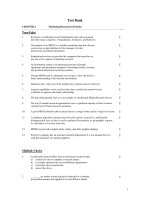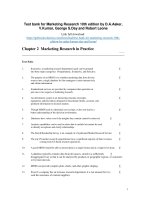Lecture Marketing research (12th edition) - Chapter 20: Discriminant, factor and cluster analysis
Bạn đang xem bản rút gọn của tài liệu. Xem và tải ngay bản đầy đủ của tài liệu tại đây (816.23 KB, 48 trang )
1
Marketing Research
Aaker, Kumar,
Leone and Day
Twelfth Edition
Instructor’s
2
Chapter Twenty
Discriminant, Factor and Cluster
Analysis
/
Marketing Research 12th Edition
3
Discriminant Analysis
•
•
Used to classify individuals into one of two or more
alternative groups on the basis of a set of measurements
Used to identify variables that discriminate between
naturally occurring groups
Major Uses
Prediction
/
Description
Marketing Research 12th Edition
4
Objectives of Discriminant
Analysis
•
•
•
•
/
Determining linear combinations of the predictor variables to
separate groups by measuring betweengroup variation relative to
withingroup variation
Developing procedures for assigning new objects, firms, or
individuals, whose profiles, but not group identity are known, to one
of the two groups
Testing whether significant differences exist between the two groups
based on the group centroids
Determining which variables count most in explaining intergroup
differences
Marketing Research 12th Edition
5
Basic Concept
If we can assume that two populations have the same variance, then the
usual value of C is
where X1 and XII are the mean values for the two groups, respectively.
Distribution of two populations
/
Marketing Research 12th Edition
6
Discriminant Function
Zi = b1 X1 + b2 X2 + b3 X3 + ... + bn Xn
Where
Z
= discriminant score
b = discriminant weights
X = predictor (independent) variables
In a particular group, each individual has a discriminant score (zi)
Σ zi = centroid (group mean); where i = individual
Indicates most typical location of an individual from a
particular group
/
Marketing Research 12th Edition
7
Discriminant Function –
A Graphical Illustration
/
Marketing Research 12th Edition
8
Cutoff Score
•
Criterion against which each individual’s discriminant score is
judged to determine into which group the individual should be
classified
For equal group sizes
/
For unequal group sizes
Marketing Research 12th Edition
9
Determination of Significance
•
•
•
/
Null Hypothesis: In the population, the group means the
discriminant function are equal
Ho : μA = μB
Generally, predictors with relatively large standardized
coefficients contribute more to the discriminating power of
the function
Canonical or discriminant loadings show the variance that
the predictor shares with the function
Marketing Research 12th Edition
10
Classification and Validation
Holdout Method
•
•
•
/
Uses part of sample to construct classification rule; other subsample
used for validation
Uses classification matrix and hit ratio to evaluate groups
classification
Uses discriminant weights to generate discriminant scores for cases in
subsample
Marketing Research 12th Edition
11
Classification and Validation (Contd.)
U method or Cross Validation
•
•
Uses all available data without serious bias in estimating
error rates
Estimated classification error rates
P1 = m1/ n1 P2 = m2 / n2
where m1 and m2 = number of sample observations
misclassified in groups G1 and G2
/
Marketing Research 12th Edition
12
Steps in Discriminant Analysis
1.
Form groups
2. Estimate discriminant function
3. Determine significance of function and variables
4. Interpret the discriminant function
5. Perform classification and validation
/
Marketing Research 12th Edition
13
Multiple Discriminant Analysis
•
Number of possible discriminant functions
= Min (p, m1)
Where M = number of groups
P = number of predictor variables
Assumptions Underlying the Discriminant Function
The p independent variables must have a multivariate normal
distribution
2. The p x p variance–covariance matrix of the independent variables in
each of the two groups must be the same
1.
/
Marketing Research 12th Edition
14
Multiple Discriminant Analysis
/
Marketing Research 12th Edition
15
Multiple Discriminant Analysis
/
Marketing Research 12th Edition
16
Multiple Discriminant Analysis
/
Marketing Research 12th Edition
17
Factor Analysis
•
•
Combines questions or variables to create new
factors
Combines objects to create new groups
Uses in Data Analysis
▫
▫
/
To identify underlying constructs in the data from the groupings of
variables that emerge
To reduce the number of variables to a more manageable set
Marketing Research 12th Edition
18
Factor Analysis (Contd.)
Methodology
•
Principal Component Analysis
▫ Summarizes information in a larger set of variables
to a smaller set of factors
•
Common Factor Analysis
▫ Uncovers underlying dimensions surrounding the
original variables
/
Marketing Research 12th Edition
19
Factor Analysis Example
/
Marketing Research 12th Edition
20
Principal Component Analysis
•
Since the objective of factor analysis is to represent each of the variables
as a linear combination of a smaller set of factors, it is expressed as
Where
Xx1 through x5 represent the standardized scores
F1 through F5 are the standardized factor scores,
I11, In1,....In2 are factor loadings
e1–e5 are error variances
/
Marketing Research 12th Edition
21
Factors
Factor
▫ A variable or construct that is not directly
observable but needs to be inferred from the input
variables
▫ All included factors (prior to rotation) must explain
at least as much variance as an “average variable”
Eigenvalue Criteria
▫ Represents the amount of variance in the original
/
variables that is associated with a factor
▫ Sum of the square of the factor loadings of each
Marketing Research 12th Edition
22
How Many Factors Criteria
Scree Plot Criteria
▫ A plot of the eigenvalues against the number of factors,
in order of extraction.
▫ The shape of the plot determines the number of factors
/
Marketing Research 12th Edition
23
How Many Factors: Criteria (Contd.)
Percentage of Variance Criteria
▫ The number of factors extracted is determined so
that the cumulative percentage of variance extracted
by the factors reaches a satisfactory level
Significance Test Criteria
▫ Statistical significance of the separate eigenvalues is
determined, and only those factors that are
statistically significant are retained
/
Marketing Research 12th Edition
24
Common Terms
Factor Scores
▫ Values of each factor underlying the variables
Factor Loadings
▫ Correlations between the factors and the original
variables
Communality
▫ The amount of the variable variance that is explained by
/
the factor
Marketing Research 12th Edition
25
Factor Rotations
§
/
Solutions generated by factor analysis for a data set.
Marketing Research 12th Edition









